Editor’s note: The following is extracted from Indian Fights and Fighters, by Cyrus Townsend Brady (published 1904). All spelling in the original.
I. The Cause of the Fighting
Late in 1876 the government determined that thereafter all Indians in the Northwest must live on the reservations. For a long time the Interior Department, to which the management of Indian affairs was committed, had been trying in vain by peaceable means to induce them to do this. The Indians were at last definitely informed that if they did not come into the reservation by the first of January, 1876, and stay there, the task of compelling them to do so would be turned over to the War Department. They did not come in; on the contrary, many of those on the reservations left them for the field; and thus the war began.
The principal adviser and most influential head man among the Sioux Nation and its allied tribe, the Cheyennes, was Sitting Bull, an Unkpapa chief and a great medicine man. He does not seem to have been much of a fighter. The Indians said he had a big head but a little heart, and they esteemed him something of a coward; in spite of this, his influence over the chiefs and the Indians was paramount, and remained so until his death.
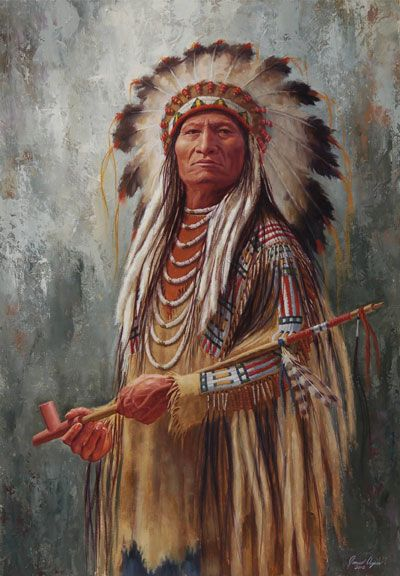
Perhaps he lacked the physical courage which is necessary in fighting, but he must have had abundant moral courage, for he was the most implacable enemy and the most dangerous—because of his ability, which was so great as to overcome the Indians’ contempt for his lack of personal courage—that the United States had ever had among the Indians. He was a strategist, a tactician—everything but a fighter. However, his lack of fighting qualities was not serious, for he gathered around him a dauntless array of war chiefs, the first among them being Crazy Horse, an Oglala, a skilful and indomitable, as well as a brave and ferocious, leader.
The Sioux country was encircled by forts and agencies. The Missouri River inclosed it on the east and north. On the south were the military posts along the line of the Union Pacific Railroad. To the west were the mountains. Sitting Bull and his followers took position in the valleys of the Big Horn near the sources of the Powder River, right at the center of the encircling forts and agencies. It was a situation whence they could move directly upon the enemy in any direction as necessity required.
For years unscrupulous and mercenary traders had supplied the savages with high-grade firearms in spite of government protests. The Indians were better armed than the soldiers, and possessed ammunition in plenty. Their numbers in the field have been estimated at from twelve hundred to six thousand warriors, with their wives and children. Those who have studied the war from the Indian point of view have put the number at the lower figure; nearly every one else at from three thousand up. Whatever the facts, there were enough of them to give the United States Army the busiest time that it had enjoyed since the Civil War.
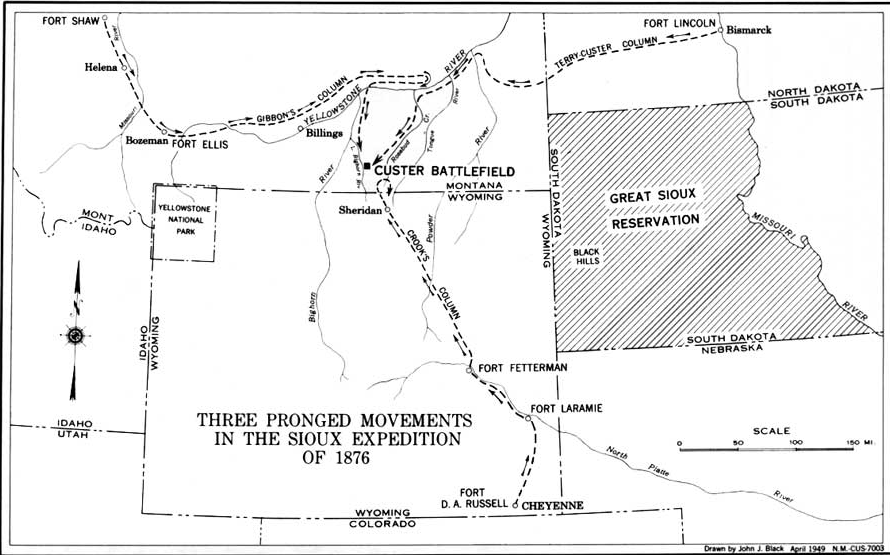
Three expeditions were planned for the winter, which were to be launched upon the Indians simultaneously. One, under General Gibbon, was to come eastward from western Montana; another, under General Crook, was to advance northward from southern Nebraska; and the third, under Custer, was to strike westward from Fort Lincoln. It was believed that any one of the three, each of which comprised more than a thousand men, would be strong enough to defeat the Indians, the only problem being to catch them or corner them.
The well-known disinclination of Indians to fight pitched battles is a factor which enters largely into every campaign. Somehow or other, the Indians in this campaign did not seem to be so disinclined that way. One cannot but admire the skill with which they manœuvered and the courage with which they fought. Putting aside all questions of their cruelty and brutality—and what else could be expected from them?—they were patriots fighting for the possession of their native land. Bravely they fought, and well. They were fully apprised of the movements of the troops, and resolved to attack them in severalty and beat them in detail. We shall see how completely they did so, and with what brilliant success they battled, until they were run down, worn out, scattered, killed, or captured.
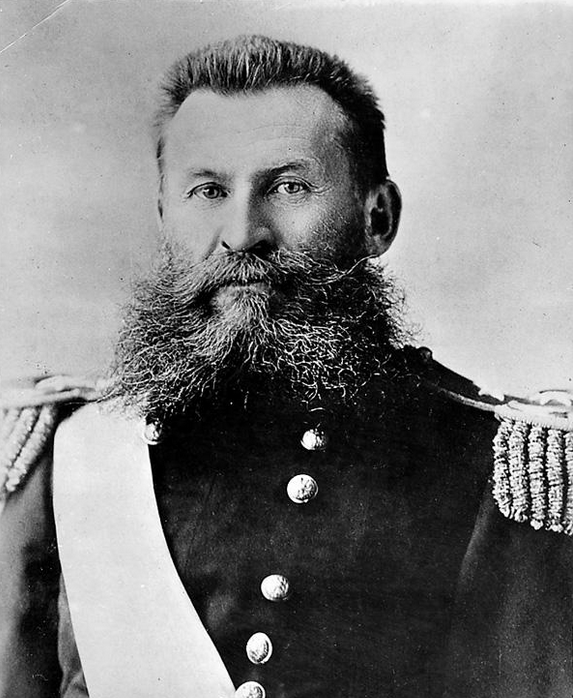
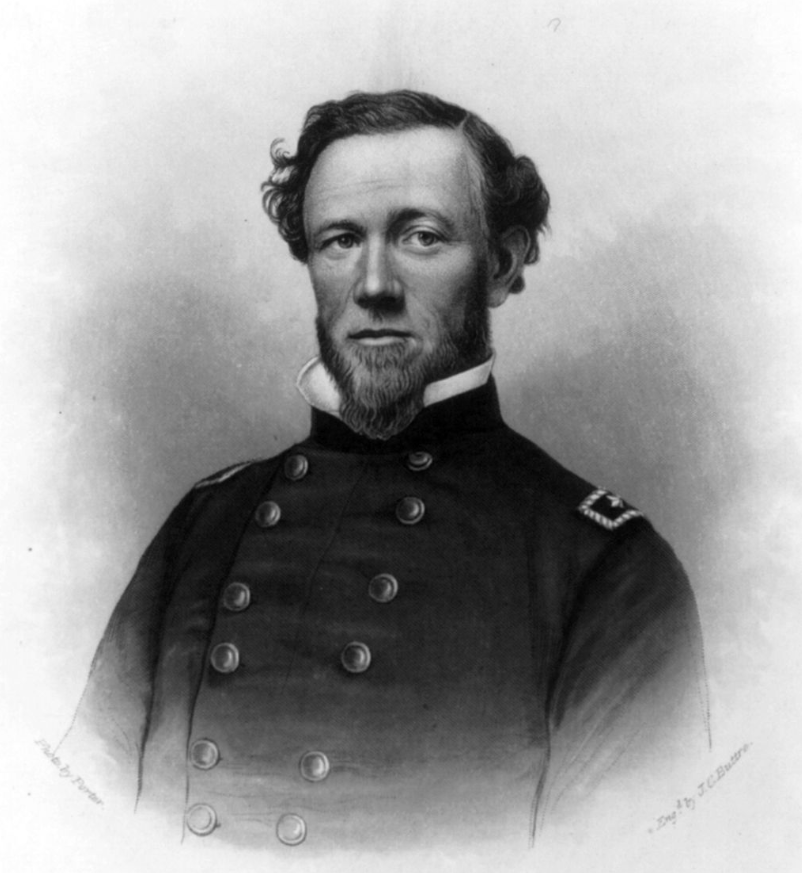
II. Reynolds’ Abortive Attempt
The weather was something frightful. Indeed, all through the ensuing spring it was unprecedentedly inclement. Neither Custer’s expedition nor Gibbon’s got away in winter. Crook did advance, and first came in touch with the enemy with results not altogether satisfactory. General Joseph J. Reynolds, with ten troops from the Second and Third Cavalry, surprised and took possession of Crazy Horse’s village, on the Powder River, on the morning of March 17, 1876. The troops had partially destroyed the village while under a severe fire from the Indians who had rallied on bluffs and hills round about it, when Reynolds abandoned the position and retreated. He was, of course, pursued by the Indians, grown bolder than before, if possible, as they saw the reluctant soldiers giving up their hard-won prize.
So precipitate was Reynolds’ withdrawal, in fact, that the bodies of several troopers who had been shot in the action were abandoned to the malignity of the savages, and there was a persistent whisper, which will not down, to the effect that one wounded man was also left behind.
As to this, an army officer of high rank personally stated to me that Reynolds was in such a state of excitement, as the afternoon wore away and Crook did not join him in the village, that he finally peremptorily ordered the troops to mount and go away, in spite of the fact that the work of destruction was not complete. This was bad enough, but my informant solemnly asserted that Reynolds, in spite of plea and even remonstrance, compelled him to leave behind a wounded trooper, who must necessarily have been tortured by the Indians so soon as they reoccupied the village. Captain Bourke has gone on record in his “On the Border with Crook,” expressing his belief in the truth of this charge, which forever stains the name of the commander of the expedition. The whole affair was a disgrace to the army, and many of the officers of the command, capable and brave men, felt it keenly. They chafed for a chance to show their qualities, which they had later on.
The cold was intense, the temperature dropping to thirty degrees below zero. The soldiers suffered greatly in the retreat. The Indians, who seemed impervious to cold, pursued them and succeeded in recapturing their pony herd of some seven hundred head, which Reynolds was endeavoring to bring away with him. Crook, bringing up the infantry and wagons, was furious when he met the retreating cavalry and heard its story.
There were a number of courts-martial subsequently, but little came of them, and the matter was finally allowed to drop upon the retirement or resignation of some of the officers chiefly concerned. It was a disgraceful affair, and all the honors rested with Crazy Horse. The Indians were greatly encouraged. The loss of the troops was four men killed and six wounded, and sixty-six men badly frozen or otherwise incapacitated by the cold.
III. The March to the Tongue River
After the ignominious outcome of Reynolds’ attack upon the village of Crazy Horse, the various expeditions noted spent the greater part of the spring in preparing for the grand advance of the converging columns which were to inclose the recalcitrant Indians in a cordon of soldiers, force them back on the reservations, and thus, it was sincerely hoped, end the war. It will be necessary to follow the movements of the several columns separately. As that of Crook first came in contact with the Indians, its history will be first discussed.
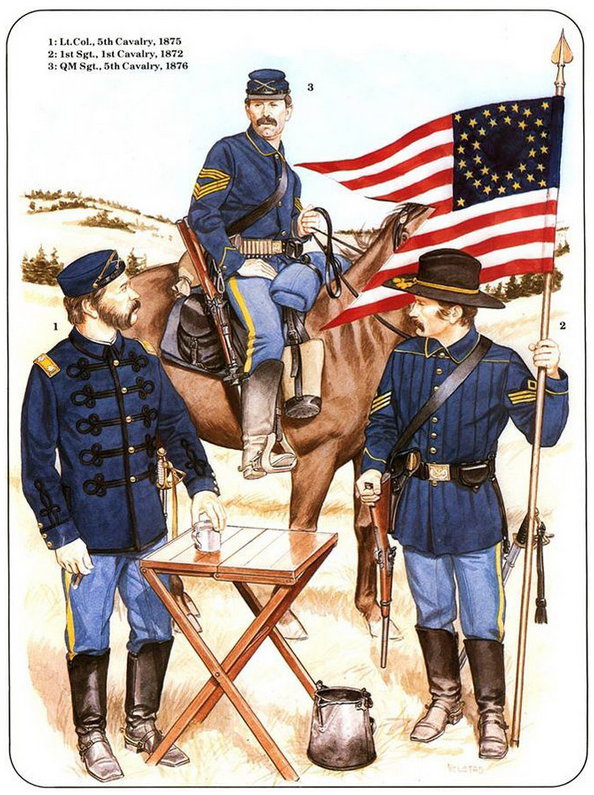
The reorganized command for the campaign, which assembled at Fort Fetterman, Wyoming, included fifteen troops of cavalry—about nine hundred men—ten of the Third, under command of Colonel Evans, and five of the Second, under Major Noyes, the whole being under the command of Colonel William B. Royall, of the Third. There were also three companies of the Ninth Infantry and two of the Fourth, a total of three hundred men, under the command of Colonel Chambers.
There was an abundance of transportation, a long wagon train, and an invaluable pack train. The troops were generously provided with everything necessary for the hard work before them. It was the largest, and it was believed to be the most efficient, force which had ever been sent against the Indians in the West.
Crook, an officer of large experience, especially in Indian fighting, assumed personal command of the expedition on the 28th of May, 1876. On the 29th the march began. The objects of the campaign were the villages of Crazy Horse and Sitting Bull, which were believed to be somewhere on the Rosebud River. The topography of that country is well known now, but then it was more or less of a terra incognita—rather more than less, by the way. Certainly, this was true after the Tongue River was reached. The advance was made at first up the Bozeman trail, past Fort Reno, and over the battle-fields around the ruins of abandoned and destroyed Fort Phil Kearney, which were objects of much interest to the soldiers.
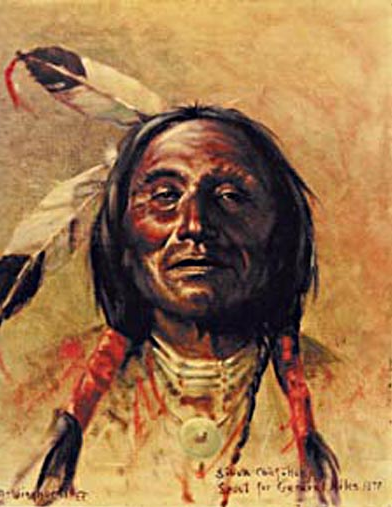
On the 9th of June the army encamped on the south side of the Tongue River, near the point where that stream intersects the Montana boundary line. Crazy Horse had been fully advised by disaffected Indians at the agencies and military posts, as well as by his own daring scouts, of all these preparations that were being made to overwhelm him. He had sent to Crook a specific warning not to cross the Tongue River, and declared his intent to attack him immediately he reached that stream. To prove that his threat was no idle boast, he mustered his warriors, and at half after six o’clock on the evening of the 9th, from the high bluffs on the other side, opened fire upon the camp.
Through a fortunate mistake the Indians directed their fire to the tents of the camp, imagining that they would be full of men. They happened to be empty. The Sioux soon got the range, and the camp was swept with bullets. They ripped open mess chests, shattered the sides of the wagons, destroyed the baggage, killed a few horses, but did little damage to the men.
The Third Cavalry was divided into three battalions, one of four, and two of three troops each. Captain Mills commanded the first battalion, Captain Henry the second, Captain Van Vliet the third. Crook acted promptly. He sent forward three companies of his infantry, deploying them as skirmishers, to line the river bank and open fire on the Indians in plain view on the bluff on the other side. At the same time he ordered Captain Mills to take his battalion across the river and charge the enemy. The Sioux were already unsettled by the accurate fire of the infantry with their long-range rifles, and as Mills’ battalion deployed, dashed through the water and at the steep bluffs on the other side, they broke and fled, having suffered little or no loss, and not having inflicted much more.
IV. The Flying Column
The skirmish was simply a grim earnest of the determined purpose of the Indian chief. No pursuit was attempted at that time. Negotiations had been entered into between the Crows, who were the hereditary enemies of the Sioux, and the Shoshones, with a view to securing a body of Indian auxiliaries to the troops, whose services would be invaluable for scouting. Persuaded thereto by Frank Gruard, a celebrated scout, something less than two hundred Crows, with eighty odd Shoshones, joined the army on the 15th of June.
To pursue Indians while incumbered with infantry and a wagon train was well nigh a hopeless task. Crook determined to park the wagons and baggage, leave them under the command of Major Furey, the quartermaster, strip his command to the lightest marching order, and make a dash for the Rosebud River and the Indian country. One hundred infantrymen, protesting most vehemently against their orders, to their credit, be it said, were detailed to remain with the train. Two hundred others, who professed to have some skill in riding, were mounted on the mules of the wagon train to accompany the cavalry.
The morning of the 15th was spent in accustoming the infantrymen to the mules and the mules to the infantrymen. The cavalrymen and the Indian allies enjoyed the circus which ensued when the mules were bridled and saddled for the first time, and mounted by men who had never before straddled anything more formidable than a fence rail. It took the whole morning before the infantrymen and the mules learned to get along with each other, even in a half-hearted way.
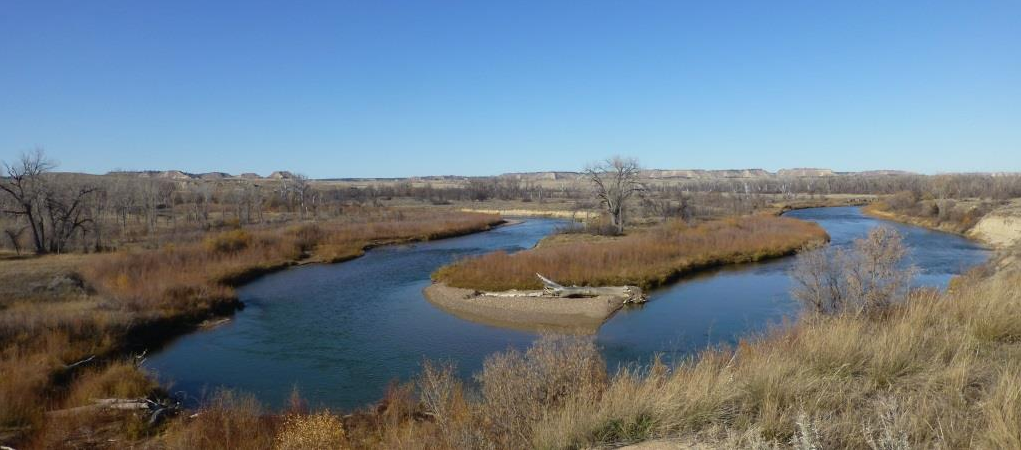
At five A.M., on the 16th, the force, numbering a little less than eleven hundred men, with two hundred and fifty Indian auxiliaries, crossed the Tongue River and marched to the Rosebud. They bivouacked that night on the banks of the Rosebud, on a level depression surrounded by low bluffs on all sides, forming a sort of natural amphitheater, on the top of which the pickets were stationed. Each man carried four days’ rations of hardtack, coffee, and bacon in his saddle-bags and one hundred rounds of ammunition upon his person. The pack train was limited to two mules carrying the medical supplies. There being little to do at the wagon camp on Goose Creek, a number of mule packers, led by a veteran, Tom Moore, accompanied the expedition to help the foot soldiers to manage their mules, and incidentally to take part in the fighting. There were no tents, of course, and but one blanket (a single blanket at that) for each man. This blanket barely kept off the heavy dew, and the night was a thoroughly uncomfortable one.
At three A.M. on the 17th of June reveillé was sounded. After breakfast and the care of the horses and mules, six o’clock found the troops on the march down the Rosebud. At eight o’clock they halted and unsaddled their animals to give them a nibble of grass and a little rest, preparatory to a farther advance later on, while the Crows and Shoshones were sent on ahead to scout. The place in which they had stopped was an amphitheater, like their camp ground of the night before, a rolling bit of boggy prairie, inclosed on all sides by bluffs, every point being within rifle shot of the center. Through this amphitheater ran the Rosebud River, here a mere creek, its general direction being from west to east. Toward the east side of the amphitheater the creek was diverted to the left, the northeastward, and plunged into a gloomy and forbidding cañon, called the Dead Cañon of the Rosebud. The course of the river was marked by a rank undergrowth of grass, small trees, etc.
Mills’ battalion of the Third Cavalry halted on the south bank of the creek. In rear of Mills was Noyes’ battalion of the Second Cavalry. Across the creek were Henry’s and Van Vliet’s battalions of the Third Cavalry, the mounted infantrymen, and the small pack train with the packers. Crook desired to keep his movements secret, but it had been impossible to restrain the impetuosity of the Indian auxiliaries the day before. They had come across a herd of buffalo and had made great slaughter of the helpless animals, killing one hundred and fifty of them, for which they had no use at all. It is certain that so able a general as Crazy Horse had scouts watching Crook all the time, and would have discovered his advance in any event; but with all the noise made by the Indians in the buffalo hunt, there was no possibility of a surprise. As a matter of fact, it was Crazy Horse who began the game. Crook was ready for him.
V. The Battle of the Rosebud
About half after eight o’clock in the morning, the resting soldiers were called to attention by the sound of shots from the bluffs in front of them, over which their allies had disappeared. It was at first supposed that these friendly Indians had run across another herd of buffalo, but a few moments told the practised troopers that the firing was the beginning of a battle rather than that of a hunt. At the same time the Indian auxiliaries came galloping back to the main body at full speed, yelling:
“Sioux, Sioux! Heap Sioux!”
Without waiting for orders, the troopers saddled their horses and fell in. They got ready none too soon, for right on the heels of the fleeing Crows and Shoshones came the Sioux. In front of them to the right, the left, the low bluffs inclosing the plain, were ringed with Indians in full war-gear. As one observer described it to me, they looked like swarms of blackbirds, there were so many of them and in such rapid motion. They kept coming and coming into view, and as they dashed up to the brink of the hills upon their war ponies they opened a long-range fire upon the soldiers, which from the distance did little damage. There were at least a thousand of them in plain sight. How many others there might be, no one could tell. It was a safe guess that those in sight constituted but a small part of the force.
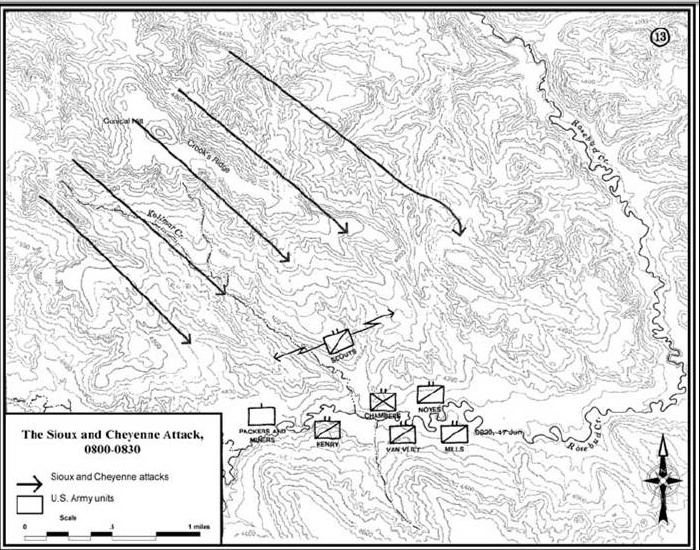
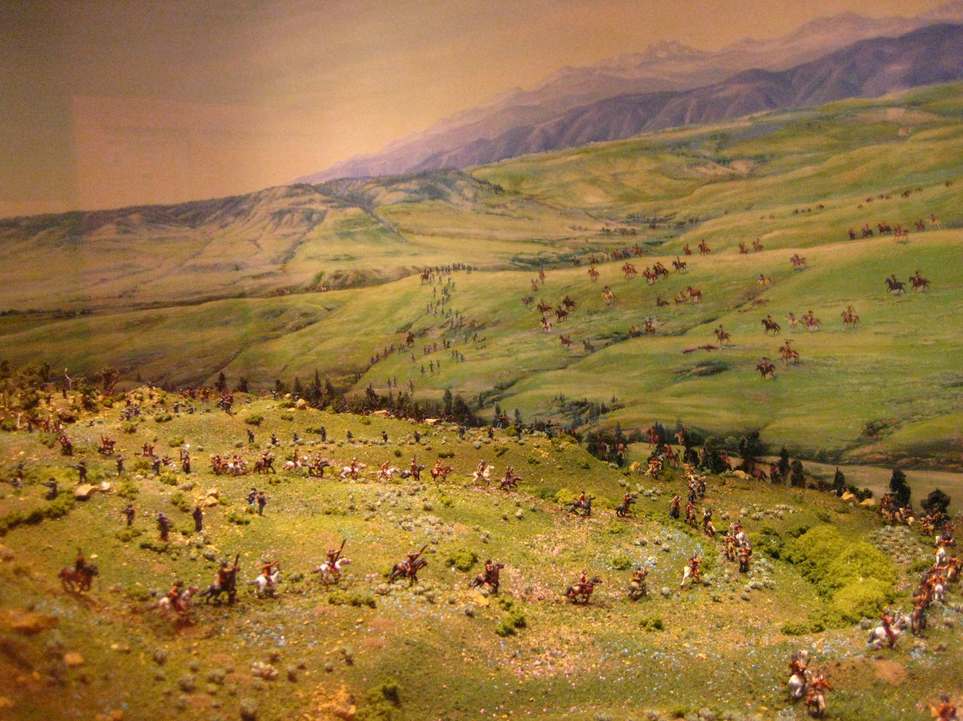
It is said that there were at least six thousand warriors that day under the command of Crazy Horse, but that most of them were not engaged. Crazy Horse had planned an ambush for General Crook, and he had hoped to defeat him by luring the soldiers into it, or by separating the army into small detachments and overwhelming them in detail. His plans were well devised, and came very near being successful. That they did not succeed is probably due more to the acts of the Indians themselves than because of the wariness of the soldiers.
Crook acted at once. Sending his staff officers to rally the Crows and Shoshones, he directed them to circle to the right and left, and make ready to fall on the flanks of the Indians. Mills, who had behaved so gallantly at the Tongue River, was ordered to charge the Indians straight up the valley to the bluff to the northward, the front. Two troops of Van Vliet’s squadron were rushed off to the southward, the rear, to seize a commanding position to prevent the Indians from circling around in that direction and getting in Crook’s rear. The infantry and part of the Second Cavalry were dismounted, and thrown forward as skirmishers around the foot of the bluffs. Royall took Henry’s battalion, with Van Vliet’s remaining troop, one of Mills’ troops which he detached while the battalion was on the gallop, and another of Noyes’ troops, and charged the Indians on the left.
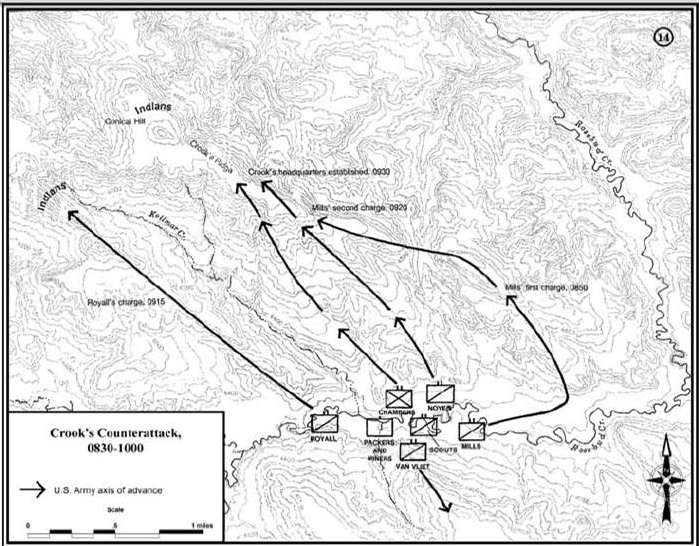
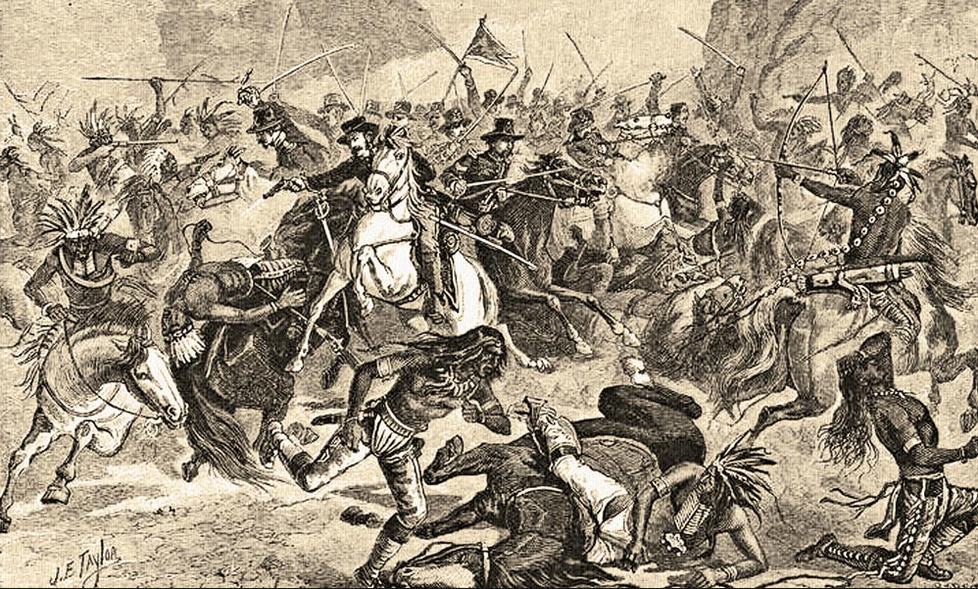
Mills’ charge was most gallantly delivered. The soldiers struggled through the bog, raced across the bottom land for about eight hundred yards, and scrambled up the bluffs in twenty minutes, finding themselves, when they reached the top, within fifty paces of the Sioux. There was no time to use carbines. Firing revolvers, the battalion rushed at the Indians. The savages fired ineffectively, gave way, and fled instantly to higher ground six hundred yards further on, where they opened fire. In their excitement they shot badly. Mills dismounted his battalion, deployed them as skirmishers, rushed the second ridge and cleared it, the Indians sullenly retiring before him, and again opened fire on the troops, to which the cavalrymen made effective reply. The Sioux galloped rapidly to and fro, yelling and firing from their horses, kicking up clouds of dust, but doing little harm.
Royall, Henry, and Van Vliet had a similar success on the left, where the ground was much more open and unfavorable for defense, although the Indians were massed more heavily in that quarter than before Mills.

Meanwhile the Crows and Shoshones had fallen upon the flanks of the Sioux, but not very effectively. Every one in the field except a small reserve was now hotly engaged. The pressure on Mills became stronger, but he drove the Indians from him by another gallant attack. Thereafter he was reinforced by Noyes’ battalion. The front of his line was finally partially cleared by this last dash. The Indians who had been attacking him thereupon left him, and joined the others before Royall and Henry.
Crook now withdrew Mills’ command from the battlefield, and Mills was ordered to take his three troops down the Dead Cañon of the Rosebud and attack the villages which it was believed the Indians were defending. Mills’ movements were supported by the five troops of the Second Cavalry under Noyes. Crook promised to follow up the movement, and support it with the remaining cavalry and infantry. We will follow this movement later.
Mills’ place in the line was occupied by Tom Moore and his packers and some other auxiliaries from the camp, and a smart fire was kept up in that direction. On the left the firing was fast and furious. The Indians from the front cleared by Mills joined their associates on the left, and again and again attacked Royall, Henry, and Van Vliet, who had joined the other two, with the most determined courage. Charge and counter charge were made over that portion of the field. Now the troops gave way before the Indian advance, now the soldiers were rallied and hurled back the Indians, now the Indians retreated before some desperate countercharge. So went the varying fortunes of the hour. The number of savages increased with every passing moment. To the eyes of the astonished soldiers they seemed to spring from the ground. If one fell in the line, a dozen were ready to take his place.
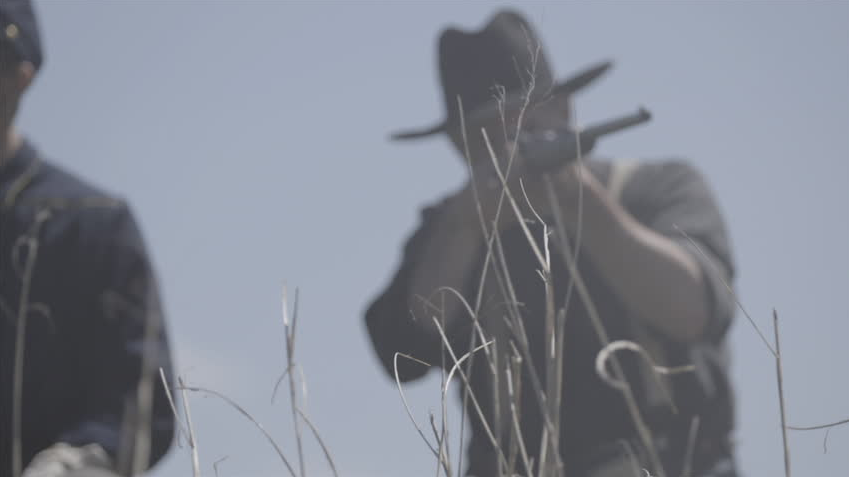
In one of the charges Captain Henry was shot through the face and frightfully wounded. The troopers had dismounted, but the officers remained mounted. Henry reeled in his saddle as the bullet pierced both his cheek bones and tore out the whole front of his face below the eyes. Although, as an eye-witness has it, he was spitting blood by the handful, he continued on the battle line. The situation of Royall’s wing of Crook’s army was precarious. Henry’s battalion held the extreme left flank. It was his duty to remain there. Vroom’s troop L, of the Third Cavalry, had become separated from the main body during the battle, and was caught ahead of the line and surrounded by Indians, in imminent danger of annihilation. Crook had ordered Royall to bring his men back to their horses, in order to mount them and prepare for a general charge. The Indians took this movement for a retreat, and came dashing after the retrograding troopers. Only the cool courage of Royall and Henry, and the magnificent way in which they handled their forces when they went forward to the rescue, prevented the annihilation of Vroom’s troops.
It was in the midst of this operation that Henry received his fearful wound and stayed on the line. Presently he fell from his horse. As he did so, the soldiers, dismayed by his fall, began to give back before the Sioux. The impetuous Indians charged over the place where Henry lay. Fortunately, he was not struck by the hoofs of the galloping horses. His men rallied and rushed to his rescue. Old Chief Washakie and his Shoshones at this period of the fighting displayed splendid courage. The fight actually raged over the body of Captain Henry until the Indians were driven off, and Henry was rescued from what would otherwise have been certain death. After this fierce struggle, part breaking through the line and part turning the flank, the Indians galloped down the valley between the river and the troops, and finally disappeared on the other side of the Dead Cañon, their retreat accelerated by the movement of Mills toward the village. The fighting had lasted a little more than two hours.
VI. Mills’ Advance down the Cañon
Meanwhile Mills and his men, in a column of twos, trotted down the gloomy depths of the Dead Cañon, the rocky walls of which, towering on either side, would have afforded abundant cover for Indian riflemen. Before entering the cañon, they had cleared the mouth of it of a body of Sioux by a smart charge, and they were thereafter unmolested. They advanced rapidly but with caution, although what they could have done if attacked it is hard to see, and how caution would have saved them it is difficult to tell. They had their orders to go through the cañon and attack the village. There was nothing to do but obey. Sending them forward was a mistake which might have resulted in a terrible disaster, although nobody believed that then. The soldiers had not yet realized what fighters these Indians were. The Custer disaster was still to come, and no one imagined that so large a body as that commanded by Mills and Noyes could be defeated. If Crook had followed with his whole force, the troops under his command would have been annihilated; it is probable that not one of them would have come out of that cañon.
When Crook began to prepare to follow Mills with the rest of his force, he discovered that he had a much larger number of wounded than he had thought possible, and the doctors protested against their being left with a feeble guard while Crook with the best of the force went up the cañon. The protest was justified by the situation. Besides, the attack on Royall and Henry had not yet ceased. Crook reflected, concluded that he could not leave the field, and that Mills’ force was too weak for the work assigned it. The general thereupon despatched Captain Nickerson, of his staff, attended by a single orderly, at the imminent peril of their lives, with orders to ride after Mills and tell him to leave the cañon, defile to the left, and rejoin him at once. Crook hoped that Mills, on his return to the field, might succeed in getting in the rear of any Indians who might be lurking in the hills before Royall’s shattered line.
So rapid had been Mills’ movements, that Nickerson, although going at the full speed of his horse, did not overtake him until he had penetrated some seven miles down the cañon. Fortunately for all concerned, the command had halted where a cross cañon made an opening toward the west, and on that side the cañon was so broken and so sloping that it could be scaled by the troopers. Firing was heard to the front, and the Indians were detected massing to attack Mills’ detachment. A halt had been ordered for the purpose of making final preparations for the attack.
“Mills,” said Nickerson, as he came galloping up, “Royall has been badly handled—there are many wounded. Henry is severely hurt, and Vroom’s troop is all cut up. The General orders that you and Noyes defile by your left flank out of this cañon and return to the field at once. He cannot move out to support you and the rest on account of the wounded.”
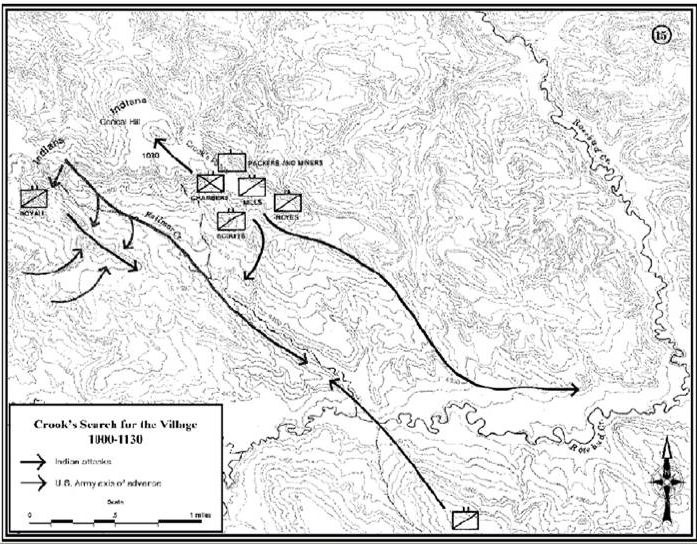
Never was order more unwelcome. The officers at the head of the column urged Mills to go on. The Indian village was in sight. Crook could not have known how near they were, or he would not have recalled them. Mills, however, was a thorough soldier. In his mind orders were to be obeyed, and he silenced the objectors and advisers, and did as he was directed, although with great disappointment and reluctance. Never was obedience better justified. General Mills admits now that, had he disobeyed Crook, his command would have been annihilated.
The cañon was the mouth of Crazy Horse’s trap. A short distance farther on, it ended in a great dam covered with broken logs, making a dangerous abattis. Here the main body of the Indians had been massed. Here they expected, seeing the confident advance of the eight troops of cavalry up the cañon, to fall upon them and kill them all, which they might easily have done. Nickerson got there just in time.
Mills instantly turned to the left and led his troops up the broken wall of the cañon to the high ground on the farther side; fortunately, he had been overtaken at about the very point where the ascent was practicable for troops. Presently the detachment rejoined the main body, their progress being unmolested.
There were ten soldiers killed and twenty-seven seriously wounded, besides a great number of slightly wounded. Most of the casualties were in Royall’s command, Vroom’s troop having lost heavily while it was in such peril.
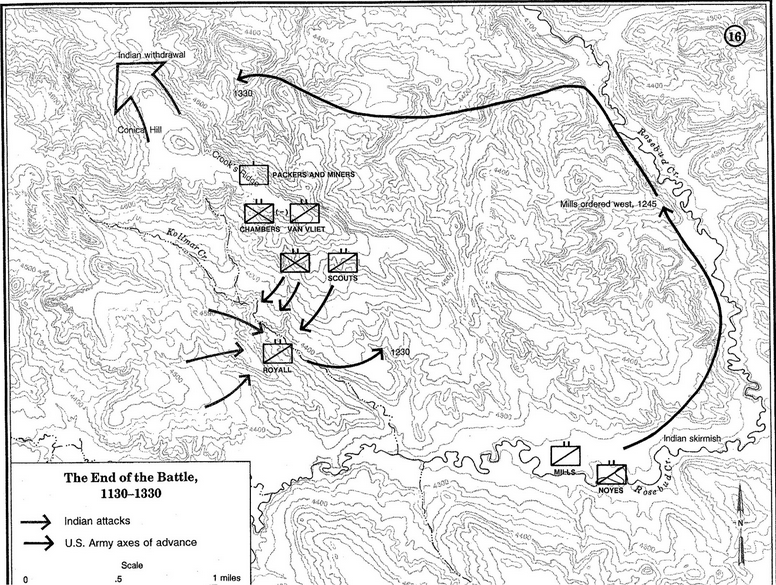
Crook camped for the night on the battle-field. The dead were buried, the wounded looked after temporarily, and the next morning the soldiers withdrew. They went back to their camp at Goose Creek and stayed there. The battle was in one sense a victory for the white soldiers, in that they drove the Indians from the field, forcing them back at least five miles. In another, and a larger and more definite sense, it was a decided victory for Crazy Horse. He had fought Crook to a standstill. He had forced him back to his base of supplies. He had stopped the farther progress of that expedition. He had protected his villages and had withdrawn his army in good order.
If Mills’ command had not been recalled, it is certain that it would have been annihilated. As it was, the Indians had done remarkably well. Crazy Horse, free from further apprehension of pursuit by Crook for the present, had leisure to turn his attention to the other two expeditions, which there is no doubt he was well aware had been launched against him.
While technically it was perhaps a drawn battle, as a feat of arms the battle of the Rosebud must go down to the credit of the Indians. It was more like a pitched battle than any that had been fought west of the Missouri heretofore. The individual officers and soldiers of the army did splendidly; so did the Indians. Mills had displayed commendable dash and daring in all his charges. Royall, Henry and Van Vliet, and Chambers with the infantry, had fought skilfully and bravely against an overwhelming force. Crook’s dispositions were good on the field, and were well carried out by his subordinates. The same may be said of Crazy Horse, his subchiefs, and their warriors.
Crook had nearly exhausted his ammunition in the hard fighting, the larger part of his supplies had been expended, and he had a number of very seriously wounded on his hands. There was not one chance in a thousand that he could catch the Indians now. There was nothing left for him to do but go back to the main camp, send his wounded back to Fort Fetterman for treatment, order up more supplies and more troops, and await a favorable opportunity to attack again.
To anticipate events, it may be noted that, owing to the disaster to Terry’s column, Crook did not advance until August.

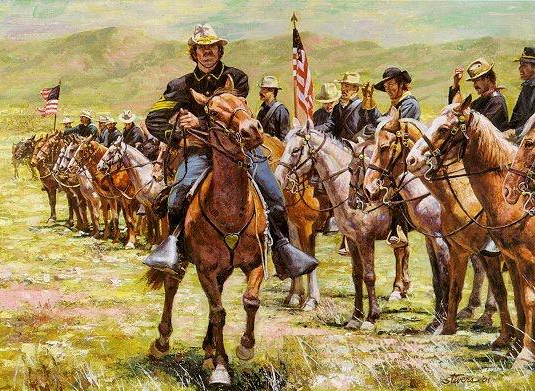

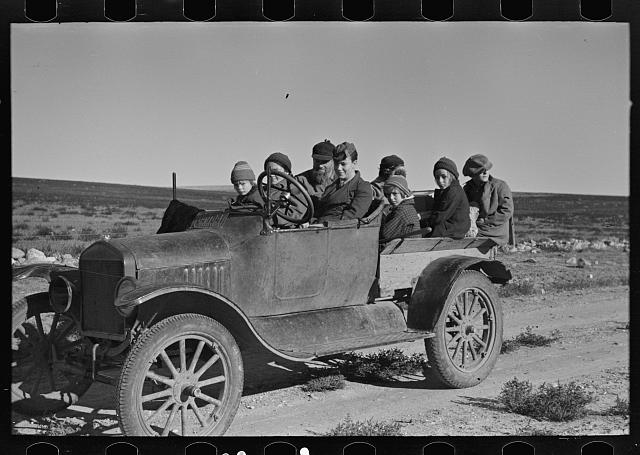
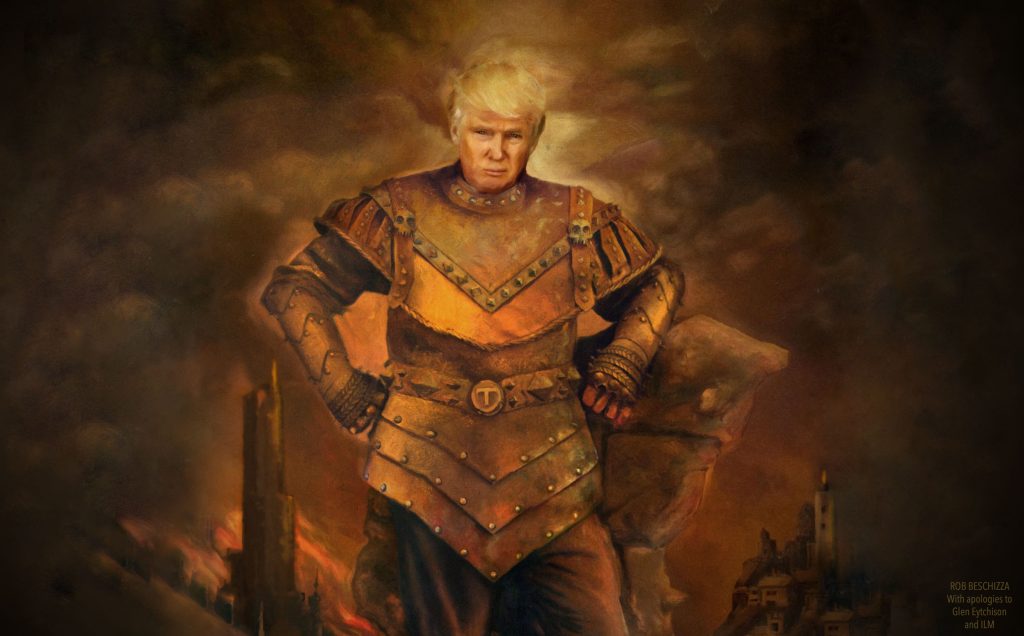
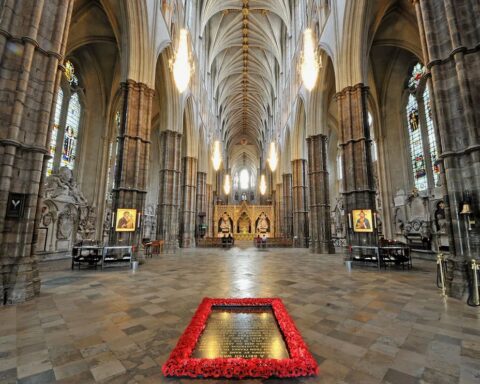
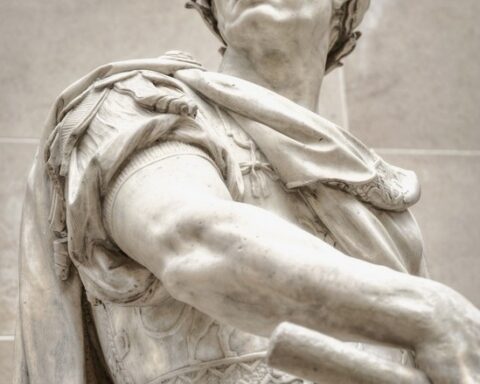
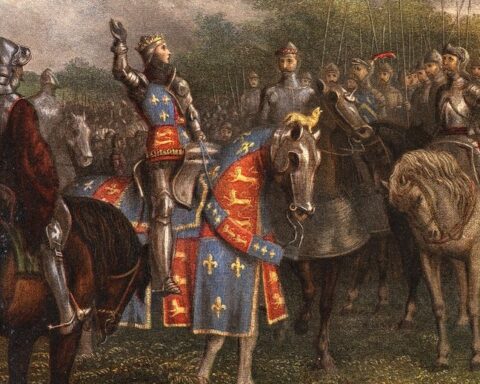
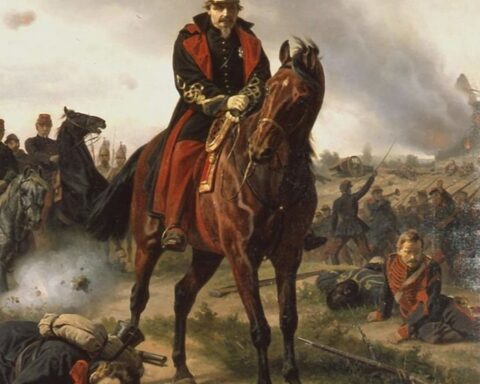
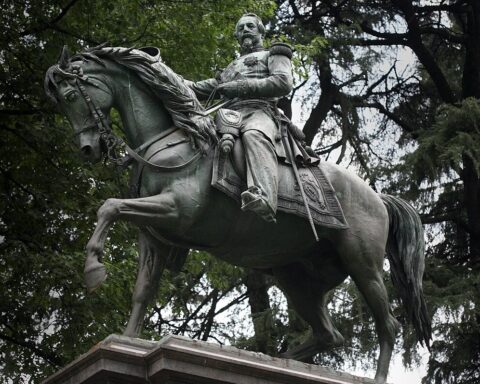
Hunh, never realized that these fights out West had actual “battle” names. Kind of stupid of me in retrospect, but it was always just sort of grouped under the general “War” (Great Sioux War, Black Hills War, etc.)
Thanks for bringing this to light Mr. Mantel, as it was exciting to read about a battle I had never even heard anything about. Keep ’em coming.
They’re like the lesser known battles of the Revolution and the Civil War (e.g., Guilford Courthouse, first and second battles of the Sabine Pass). Familiar to locals and scholars of military history, but never embedded in the general memory.